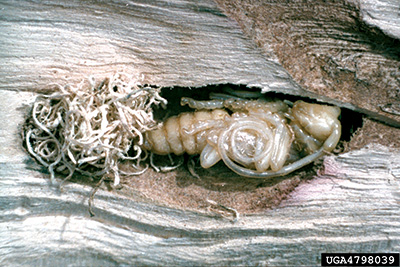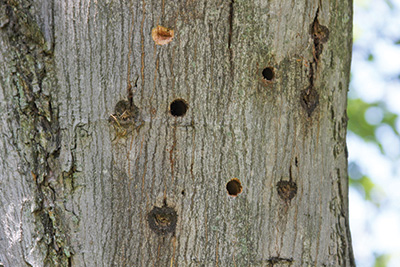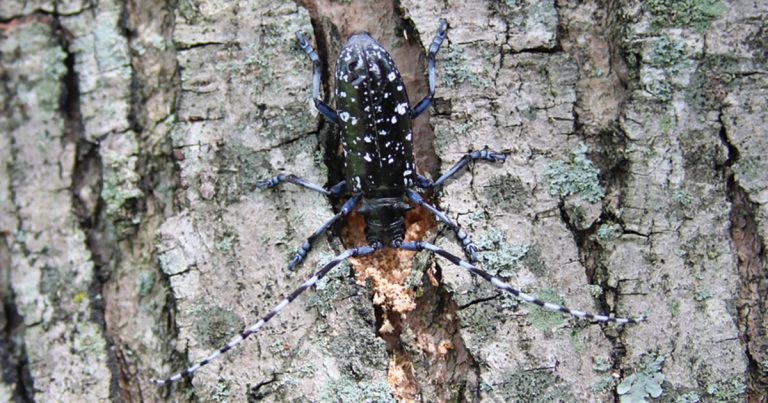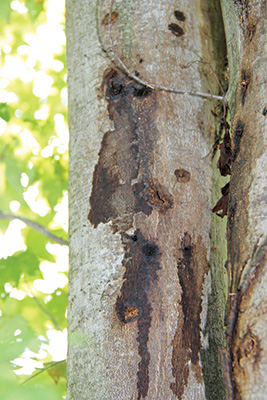Free printed copies of pest alerts are available.
The Asian longhorned beetle (ALB) (Anoplophora glabripennis) is native to China and Korea and poses a serious threat to U.S. urban and forest trees. The ALB was first discovered in the United States in 1996 on Long Island, New York. There have been six infestations of ALB in the United States: four infestations are ongoing, and two of the infestations have been successfully eradicated (see timeline at right for locations of the infestations). As ALB can be transported in untreated wood products such as wood packing materials or firewood, it is vital to be aware of this insect and immediately report anything suspicious to local authorities (state department of agriculture, USDA, National Plant Diagnostic Network).
Identification
The shiny black, bullet-shaped ALB adult is about 1 to 1.5 inches long with white spots that are irregular in size and shape. Its black-and-white banded antennae are usually longer than its body. The elongated feet are black with a whitish-blue upper surface. Adults can be seen from late spring through fall, depending on climate and geographical location. Although its size and large mandibles may cause it to appear threatening, the beetle is harmless to humans and pets.


Life Cycle
Adult females use their mandibles to chew a pit in bark and then deposit an egg into it. Each female lives several weeks and will lay up to 90 eggs. The larva tunnels under the bark, eventually tunneling deep into the tree. Larval tunneling produces frass that consists of feces and wood fibers resembling sawdust. The large, light cream-colored larva that lives entirely within the wood of trees is the most damaging stage as they consume living wood, disrupting the flow of nutrients within the tree. Typically, the life cycle of the ALB is completed in one year.
Host Plants
The ALB larvae bore deep into healthy deciduous hardwood trees. Trees categorized as preferred hosts for ALB include maple, boxelder, horsechestnut, buckeye, willow and elm. In addition, there are a number of occasional or rare hosts such as mimosa, katsura tree, ash, poplar, London plane tree, and European mountain-ash. Large, round exit holes, approximately 3/8 inch in diameter located on trunks and branches of a living and healthy tree is an early sign of an ALB infestation. Although they feed on several tree species, maple are by far the most preferred host. Another early sign of an infestation is oviposition pits. An oviposition pit is a wound in the bark made by a female beetle as she prepares to lay her eggs. These ovipostion pits can weep sap. An infested tree may have sudden branch breakage as the as the larval feeding compromises the structure of the tree. Canopy wilting and dieback occurs when larvae damage tissues that transport water and nutrients to the leaves. The ALB females often lay eggs on the same tree they emerged from, leading to multiple generations damaging the same tree. Trees usually show signs of damage 3–4 years after the initial attack with tree death occurring in 10–15 years.


Timeline of ALB Infestations and Eradications in the U.S.
Year
1996
1998
2002
2008
2011
2020
Location
Long Island, NY
Chicago, IL
Jersey City, NJ
Worchester, MA
Tate Township, OH
Hollywood, SC
Current Status
Ongoing
Eradicated in 2008
Eradicated in 2013
Ongoing
Ongoing
Ongoing
Economic and Environmental Impacts
Establishment of the ALB in the United States could cause more damage than Dutch elm disease, chestnut blight, and spongy moths combined by destroying millions of acres of hardwoods, including forest, park, and backyard trees. According to the United States Department of Agriculture, ALB is a threat to lumber, nursery, and tourism industries. Due to the enormous negative impact ALB would have in the U.S. and the success of eradication projects, this insect remains a highly regulated pest by USDA APHIS. Once a tree is infested, it must be removed. To date, over 180,000 trees have been removed in infested areas in order to protect the forests and urban landscapes of the rest of the United States. Early detection and reporting will help agencies to eradicate the pest and prevent its establishment.


Report Sightings
If you find a beetle that you suspect is an ALB, you should collect it and immediately place the pest in a glass jar, as the ALB adult is capable of chewing through plastic bags. Then put it in the freezer overnight. Be sure to report it to appropriate authorities. It is essential to note where you found the beetle. Record the following information for each sample collected: date; host plant; collector’s name; phone number; and collection location including state, county, and address or nearest intersection. Global positioning system (GPS) location information is useful, if available. To report the finding, call your state’s department of agriculture, USDA APHIS Plant Protection and Quarantine, or National Plant Diagnostic Network (NPDN) Laboratory. Find your nearest NPDN lab at www.npdn.org.
For More Information
Acknowledgements
This publication was originally produced and distributed by USDA-NIFA Integrated Pest Management Centers in cooperation with the University of California Statewide Integrated Pest Management Program; the National Plant Diagnostic Network, Western Region; USDA APHIS; USDA Forest Service; California Department of Food and Agriculture; and the Sacramento County Agricultural Commissioner.
For information about the Pest Alert program, please contact the North Central IPM Center.
This work is supported by the Crop Protection and Pest Management Program (2022-70006-38001) from the USDA National Institute of Food and Agriculture.
August 2023

